|
Begin the Kata in FUDO DACHI. Move into MUSUBI DACHI and MOKUSO on the command MOKUSO. On the next command Kanku, open eyes and wait until the command YOI. Then start perform a slow YOI DACHI with IBUKI that ends in HEIKO DACHI |
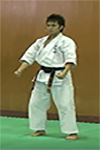
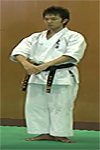
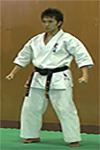 |
| 1. |
On the command HAJIME/ICHI slowly place both hands into the low KANKU KAMAE (hands open, index finger and thumb of each hand touching), in front of the groin. Slowly raise both arms into the high KANKU KAMAE above the head. Look up and maintain this position for approximately 3 seconds and part them strongly bringing both arms down in a circular action in front of the body to strike right SHUTO HIZO UCHI to the palm of the left hand. |

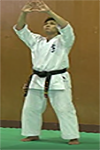
 |
| 2. |
Turn 90° counterclockwise to the left into left Kokutsu Dachi and block Shuto Mawashi Uke. |
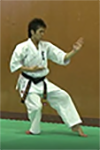 |
| 3. |
Turn 180° clockwise on the left feet into right Kokutsu Dachi and block Shuto Mawashi Uke. |
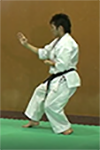 |
| 4. |
Pivot 90° counterclockwise on both feet into left Sanchin Dachi and block left Seiken Uchi Uke and immediately punch Seiken Chudan Gyaku Tsuki. |

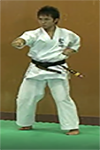 |
| 5. |
Again, while still in left Sanchin Dachi, block right Seiken Uchi Uke and punch Seiken Chudan Oi Tsuki. |
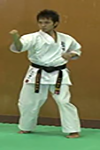 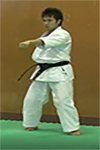 |
| 6. |
Move forward with the left foot into left Kokutsu Dachi and block Shuto Mawashi Uke (1). |
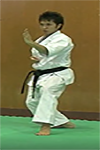 |
| 7. |
Move forward into right Kokutsu Dachi and block Shuto Mawashi Uke (2). |
 |
| 8. |
Move forward into left Kokutsu Dachi and block Shuto Mawashi Uke (3). |
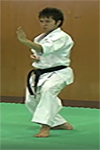 |
| 9. |
Move forward into right Zenkutsu Dachi and block with a left SHUTO OSAE UKE, followed by striking a right CHUDAN MAE YONHON NUKITE (the left hand remains open under the right elbow) and make KIAI.
|
 |
| 10. |
Bring the left foot across to the right (look to the left), simultaneously raise the left hand behind into a JODAN SHOTEI cover with the arm straight and at the same time the right hand is placed behind the head in preparation for the SHUTO strike. Turn 180° counterclockwise by pivoting the hips into left Zenkutsu Dachi and strike with a right Shuto Ganmen Uchi, simultaneously the left hand is pulled back in front of the forehead with the palm facing outwards to cover. |
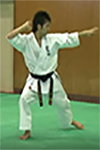  |
| 11. |
Leaving the hands in this position kick right Jodan Mae Geri and step forward into right Zenkutsu Dachi and punch Nihon Seiken Chudan Tsuki (gyaku-oi). |
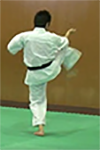  |
| 12. |
Bring the right foot across to the left (look to the right), simultaneously raise the right hand behind into a JODAN SHOTEI cover with the arm straight and at the same time the left hand is placed behind the head in preparation for the SHUTO strike. Turn 180° clockwise by pivoting the hips into right Zenkutsu Dachi and strike with a left Shuto Ganmen Uchi, simultaneously the right hand is pulled back in front of the forehead with the palm facing outwards to cover. |
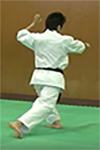 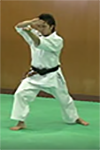 |
| 13. |
Leaving the hands in this position kick left Jodan Mae Geri and step forward into left Zenkutsu Dachi and punch Nihon Seiken Chudan Tsuki (gyaku-oi). |
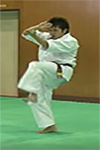 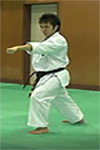 |
| 14. |
Bring back the left foot and turn 90° clockwise into Musubi Dachi and go into a left Waki no Kamae (to the left ready punch position with the right fist in the Tettsui position on top of the left fist). |
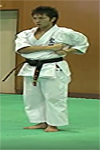 |
| 15. |
With both hands in the same position kick right Jodan Mae Geri, bring back the leg into Musubi Dachi and look to the right. Kick right Jodan Yoko Geri to the side and simultaneously strike right uraken YOKO JODAN uchi. Open the fist of the extended right arm and land in right Zenkutsu Dachi (90° clockwise from original position) and strike left Hiji Jodan Ate into the open right hand. |
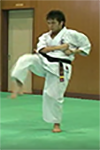 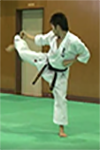 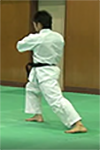 |
| 16. |
Bring back the left leg back and turn 90° counterclockwise into Musubi Dachi and go into a right Waki no Kamae. |
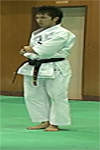 |
| 17. |
With both hands in the same position kick left Jodan Mae Geri, bring the leg back into Musubi Dachi and look to the left. Kick left Jodan Yoko Geri to the side and simultaneously strike left uraken YOKO jodan uchi. Open the fist of the extended left arm and land in left Zenkutsu Dachi (90° counterclockwise from original position) and strike right Hiji Jodan Ate into the open left hand. |
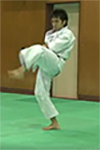  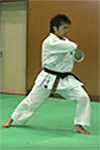 |
| 18. |
Move the right foot forward at 45° clockwise into left Sanchin Dachi and block right SEIKEN Jodan Uke, directly strike with right Uraken Ganmen Uchi, right back to HIKITE and then strike right Jodan Hiji Ate, cover with left Jodan Hiji Ate and strike right Oroshi Hiji Ate with KIAI. |
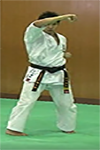 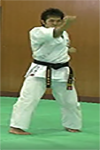 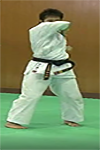 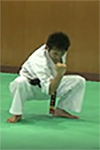 |
| 19. |
As you regain the standing position move the left leg 90° clockwise into left Sanchin Dachi at 45° and block left SEIKEN Jodan Uke, directly strike with left Uraken Ganmen Uchi, left back to HIKITE and then strike left Jodan Hiji Ate, cover with right Jodan Hiji Ate and strike left Oroshi Hiji Ate with KIAI. |
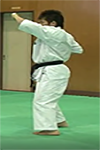 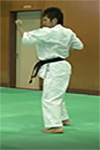 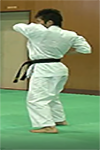  |
| 20. |
As you regain the standing position move 45° counterclockwise to the left, open both hands and simultaneously move forward into right Moro Ashi Dachi (raise knee without letting it drop back) and simultaneously block SHUTO MOROTE GEDAN BARAI (1). |
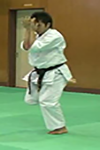 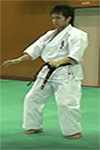 |
| 21. |
Raise both hands to cover the face and simultaneously move forward into right Moro Ashi Dachi and simultaneously block SHUTO MOROTE GEDAN BARAI (2). |
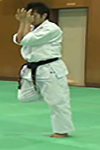 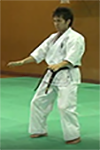 |
| 22. |
Pull back both hands into a right Waki no Kamae (right fist HIKITE on top of left SHOTEI), simultaneously move forward into right Moro Ashi Dachi, punch right SEIKEN Chudan Oi Tsuki with the left open hand placed on the right forearm. |
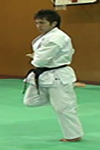  |
| 23. |
Pivot on the right foot and turn 180° counterclockwise, raise both open hands to cover the face and simultaneously move forward into left Moro Ashi Dachi and simultaneously block SHUTO MOROTE GEDAN BARAI (1). |
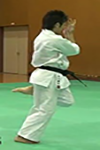 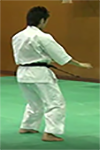 |
| 24. |
Raise both open hands to cover the face and simultaneously move forward into left Moro Ashi Dachi and simultaneously block Shuto Morote Gedan Barai (2). |
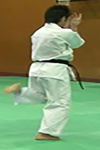 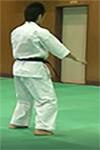 |
| 25. |
Raise both hands to cover the face and simultaneously move forward into left Moro Ashi Dachi and simultaneously block Shuto Morote Gedan Barai (3). |
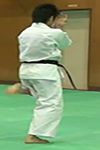 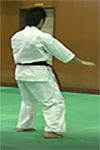 |
| 26. |
Pull back both hands into a left WAKI no KAMAE (left fist HIKITE on top of right SHOTEI), simultaneously move forward into left Moro Ashi Dachi with the right open hand placed on the left forearm. |
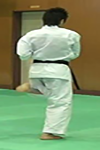 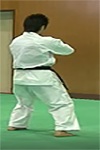 |
| 27. |
Move forward with the right leg (turning 90° counterclockwise) into Kiba Dachi and punch right SEIKEN Chudan jun Tsuki with KIAI and pull the right hand back closed into HIKITE. |
 |
| 28. |
Bring back the right foot and turn 90° clockwise into MUSUBI DACHI and go into a left Waki no Kamae. |
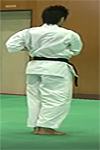 |
| 29. |
With both hands in the same position kick right Jodan Mae Geri, bring the leg back into Musubi Dachi and look to the right. Kick right Jodan Yoko Geri to the side and simultaneously strike right uraken YOKO JODAN uchi. Open the fist of the extended right arm and land in right Zenkutsu Dachi (90° clockwise from original position) and strike left Hiji Jodan ATE into the open right hand. |
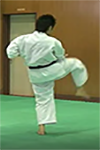 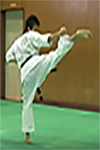 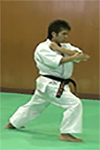 |
| 30. |
Bring back the left foot and turn 90° counterclockwise into Musubi Dachi and go in a right Waki no Kamae. |
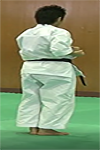 |
| 31. |
With both hands in the same position kick left Jodan Mae Geri, bring the leg back into Musubi Dachi, and look to the left. Kick left Jodan Yoko Geri to the side and simultaneously strike left uraken Yoko jodan uchi. Open the fist of the extended left arm and land in left Zenkutsu Dachi (90° counterclockwise from original position) and strike right Hiji Jodan Ate into the open left hand. |
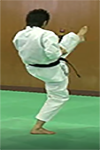 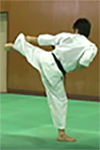 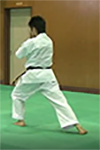 |
| 32. |
Turn your head 90° clockwise to the right and move the right foot forward into a semi right Neko ashi Dachi, simultaneously go into a left Waki Kamae. Lunge sideward to the right into right Kake Dachi and punch right TETTSUI YOKO CHUDAN UCHI UCHI and left SEIKEN CHUDAN GYAKU TSUKI (same level, SEIKEN YOKO HEIKO TSUKI). |
 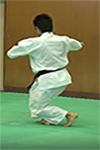 |
| 33. |
From this position move the left foot to the left into Kiba Dachi and quickly cover with a right fist to the left (position left arm under right arm, ready for a strike with the palm parallel to the ground), look to the left and slowly execute a left CHUDAN haishu uke (at shoulder height) and move the right fist into HIKITE. |
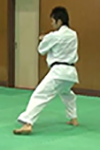 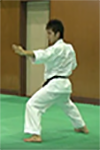 |
| 34. |
Leaving the left hand in this position, kick right MIKAZUKI GERI UKE (TEISOKU MAWASHI GERI UKE) in the open left hand, turning the body 180° counterclockwise, and before you position the right foot make a right Jodan Hiji Ate in the same open left hand, left Waki no Kamae and lunge sideward into right Kake Dachi and punch right TETTSUI CHUDAN YOKO UCHI UCHI and left SEIKEN CHUDAN GYAKU TSUKI (same level, SEIKEN YOKO HEIKO TSUKI). |
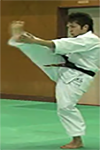 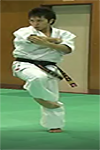  |
| 35. |
Jump up and slightly back, landing in a low right Zenkutsu Dachi with RYOTE-FUSE (both hands on the ground) in front of the right foot when the jump is completed (look forward). |
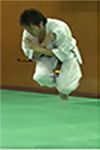 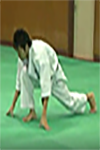 |
| 36. |
In the sameposition look to the rear and block Shuto Ushiro Morote Gedan Barai parallel to the back leg. |
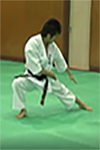 |
| 37. |
Look to the front, stand up and pull the right foot back into right Kokutsu Dachi and block right Shuto Mawashi Uke. |
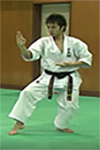 |
| 38. |
Pivot 90° counterclockwise into left Sanchin Dachi blocking left SEIKEN Uchi Uke / Gedan Barai. |
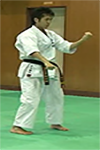 |
| 39. |
Repeat the block: right SEIKEN Uchi Uke / Gedan Barai. |
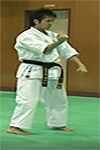 |
| 40. |
Bring the right hand slowly down in a semicircular movement into low Kanku Kamae position. Slowly raise both arms into the high Kanku Kamae position above the head. Look up and maintain this position for approximately 3 seconds and part them strongly bringing both arms down in a circular action in front of the body to strike right Shuto Hizo Uchi to the palm of the left hand. |
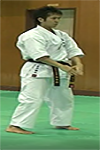 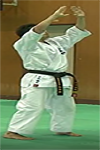  |
| 41. |
Pivot 180° clockwise on the left foot into Kiba Dachi, covering the attack with left Shotei in front of the body with the right hand open in the HIKITE position and strike right YOKO CHUDAN YONHON NUKITE. |
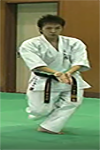  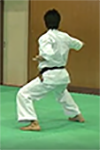 |
| 42. |
In the same Kiba Dachi turn your head 180° counterclockwise, cover with right SHOTEI and strike left YOKO CHUDAN YONHON NUKITE. |
 |
| 43. |
In the same position turn your head 90° clockwise, look forward and sweep down your left open hand, across and up to block left SHOTEI GEDAN MAWASHI UKE followed by a slow left KAKE JODAN UKE with IBUKI (right open hand stays in the HIKITE position). |
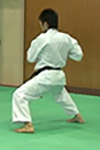 |
| 44. |
Strike right and left MAE CHUDAN YONHON NUKITE. |
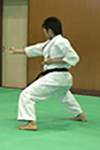 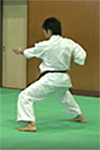 |
| 45. |
Pivot 180° counterclockwise on the right foot into Kiba Dachi, covering with right SHOTEI in front of the body with the left hand open in the HIKITE position and strike left YOKO CHUDAN YONHON NUKITE. |
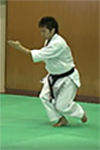 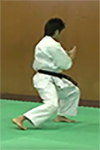 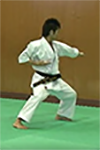 |
| 46. |
In the same KIBA DACHI turn your head 180° clockwise, cover with left Shotei and strike right YOKO CHUDAN YONHON NUKITE. |
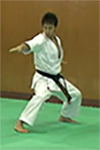 |
| 47. |
In the same position turn your head 90° counterclockwise, look forward and sweep down your right open hand, across and up to block right SHOTEI GEDAN MAWASHI UKE followed by a slow right KAKE JODAN UKE with IBUKI (left open hand stays in the HIKITE position). |
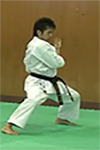 |
| 48. |
Strike left and right MAE CHUDAN YONHON NUKITE. |
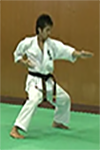 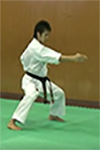 |
| 49. |
Pivot 90° counterclockwise on the left foot into Kiba Dachi, covering with left Shotei in front of the body with the right hand open in the HIKITE position and strike right Yoko Chudan Yonhon Nukite. |
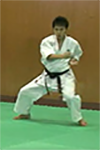 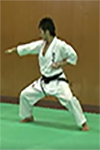 |
| 50. |
In the same KIBA DACHI turn your head 180° counterclockwise, cover with right Shotei and strike left YOKO CHUDAN YONHON NUKITE. |
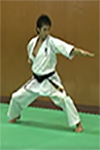 |
| 51. |
In the same position turn your head 90° clockwise, look forward and sweep down your left open hand, across and up to block left SHOTEI GEDAN MAWASHI UKE followed by a slow left KAKE JODAN UKE with IBUKI (right open hand stays in the HIKITE position). |
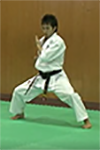 |
| 52. |
Strike right and left MAE CHUDAN YONHON NUKITE. |
 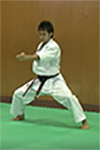 |
| 53. |
Make a cross step with the right foot to the right (MAE KOSA ASHI) into KIBA DACHI, covering with right SHOTEI in front of the body with the left hand open in the HIKITE position and strike left YOKO CHUDAN YONHON NUKITE. |
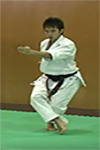  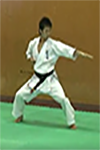 |
| 54. |
In the same KIBA DACHI turn your head 180° clockwise, cover with left SHOTEI and strike right YOKO CHUDAN YONHON NUKITE. |
 |
| 55. |
In the same position turn your head 90° counterclockwise, look forward and sweep down your right open hand, across and up to block right SHOTEI GEDAN MAWASHI UKE followed by a slow right KAKE JODAN UKE with IBUKI (left open hand stays in the HIKITE position). |
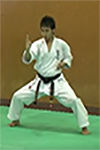 |
| 56. |
Strike left and right MAE CHUDAN YONHON NUKITE. |
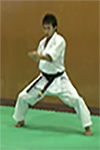 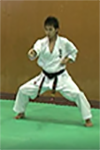 |
| 57. |
Still in the same position reach up to the right with both hands open , grab the opponent, and turn 90° counterclockwise into a left ZENKUTSU DACHI, simultaneously execute a TAI OTOSHI (the fists dosing during the execution of the throw, right fist URA). |
 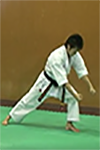 |
| 58. |
Leaving the right hand in the original position raise the left fist in preparation for a block and execute left SEIKEN GEDAN BARAI and punch right SEIKEN GEDAN GYAKU TSUKI with KIAI. |
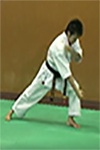  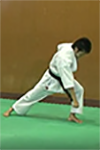 |
| 59. |
Retaining the same position, reach up to the left with the hands open, grab the opponent and execute the TAI OTOSHI as you turn 180° clockwise to the right into a stance similar to a right ZENKUTSU DACHI. |
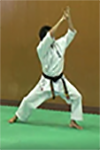 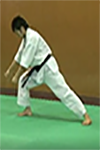 |
| 60. |
Leaving the left hand in the original position raise the right fist in preparation for a block and execute right SEIKEN GEDAN BARAI and punch left SEIKEN GEDAN GYAKU TSUKI with KIAI. |
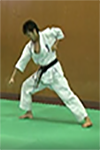  |
| 61. |
Move the left foot back into MUSUBI DACH and the MOKUSO position is retained. |
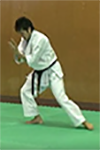 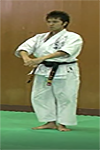 |
|
The Kata is completed on the command NAORE the FUDO DACHI position is taken.
At the command Yasmee relax and at ease.
Back to Top |
 |
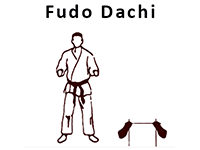 Fudo Dachi
Fudo Dachi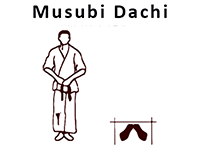 Mosubi Dachi
Mosubi Dachi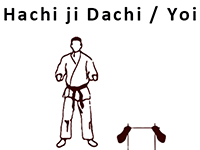 Joi Dachi
Joi Dachi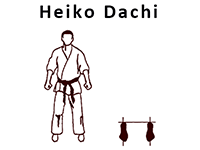 Heiko Dachi
Heiko Dachi Kokutsu Dachi
Kokutsu Dachi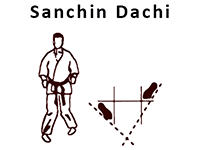 Sanchin Dachi
Sanchin Dachi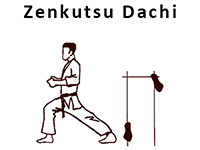 Zenkutsu Dachi
Zenkutsu Dachi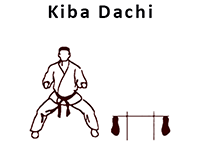 Kiba Dachi
Kiba Dachi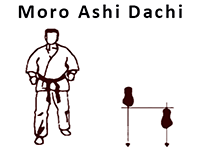 More Ashi Dachi
More Ashi Dachi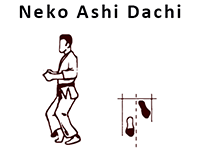 Neko Ashi Dachi
Neko Ashi Dachi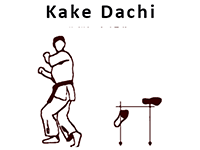 Kake Dachi
Kake Dachi Shuto Hizo Uchi
Shuto Hizo Uchi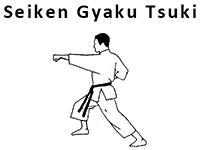 Seiken Chudan Gayku Tsuki
Seiken Chudan Gayku Tsuki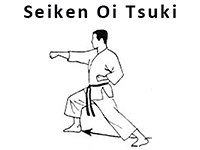 Seiken Chudan Oi Tsuki
Seiken Chudan Oi Tsuki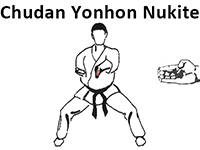 Chudan Mae Yonhon Nukite
Chudan Mae Yonhon Nukite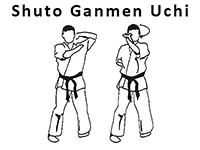 Shuto Ganmen Uchi
Shuto Ganmen Uchi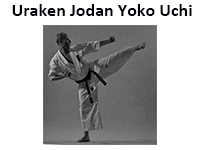 Uraken Yoko Jodan Uchi
Uraken Yoko Jodan Uchi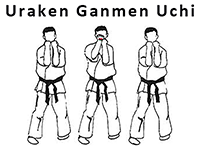 Uraken Ganmen Uchi
Uraken Ganmen Uchi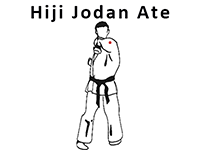 Hiji Jodan Ate
Hiji Jodan Ate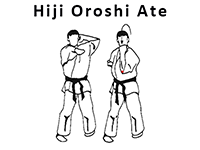 Hiji Oroshi Ate
Hiji Oroshi Ate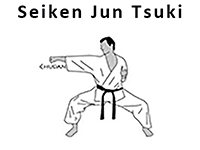 Seiken Chudan Jun Tsuki
Seiken Chudan Jun Tsuki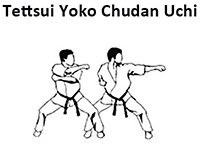 Tettsui Chudan Yoko Uchi
Tettsui Chudan Yoko Uchi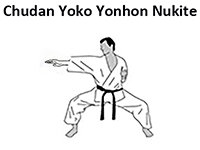 Yoko Chudan Yonhon Nukite
Yoko Chudan Yonhon Nukite Mae Chudan Yonhon Nukite
Mae Chudan Yonhon Nukite Seiken Gedan Gayku Tsuki
Seiken Gedan Gayku Tsuki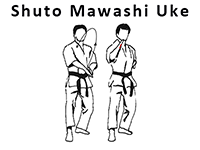 Shuto Mawashi Uke
Shuto Mawashi Uke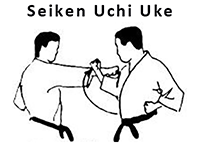 Seiken Uchi Uke
Seiken Uchi Uke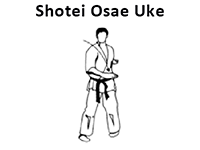 Shotei Osae Uke
Shotei Osae Uke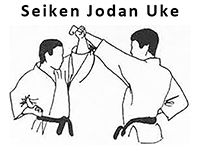 Seiken Jodan Uke
Seiken Jodan Uke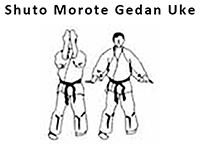 Shuto Morote Gedan Barai
Shuto Morote Gedan Barai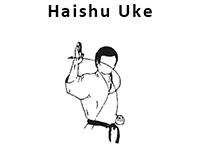 Haishu Uke
Haishu Uke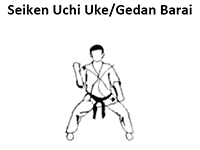 Seiken Uchi Uke / Gedan Barai
Seiken Uchi Uke / Gedan Barai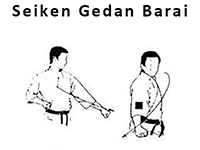 Seiken Gedan Barai
Seiken Gedan Barai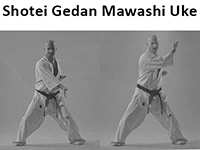 Shotei Gedan Mawashi Uke
Shotei Gedan Mawashi Uke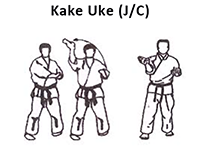 Kake Jodan Uke
Kake Jodan Uke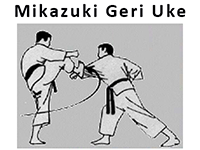 Mikazuki Geri Uke
Mikazuki Geri Uke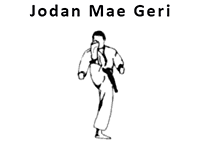 Jodan Mae Geri
Jodan Mae Geri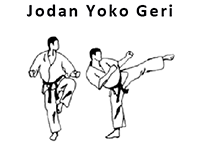 Jodan Yoko Geri
Jodan Yoko Geri



















































































































